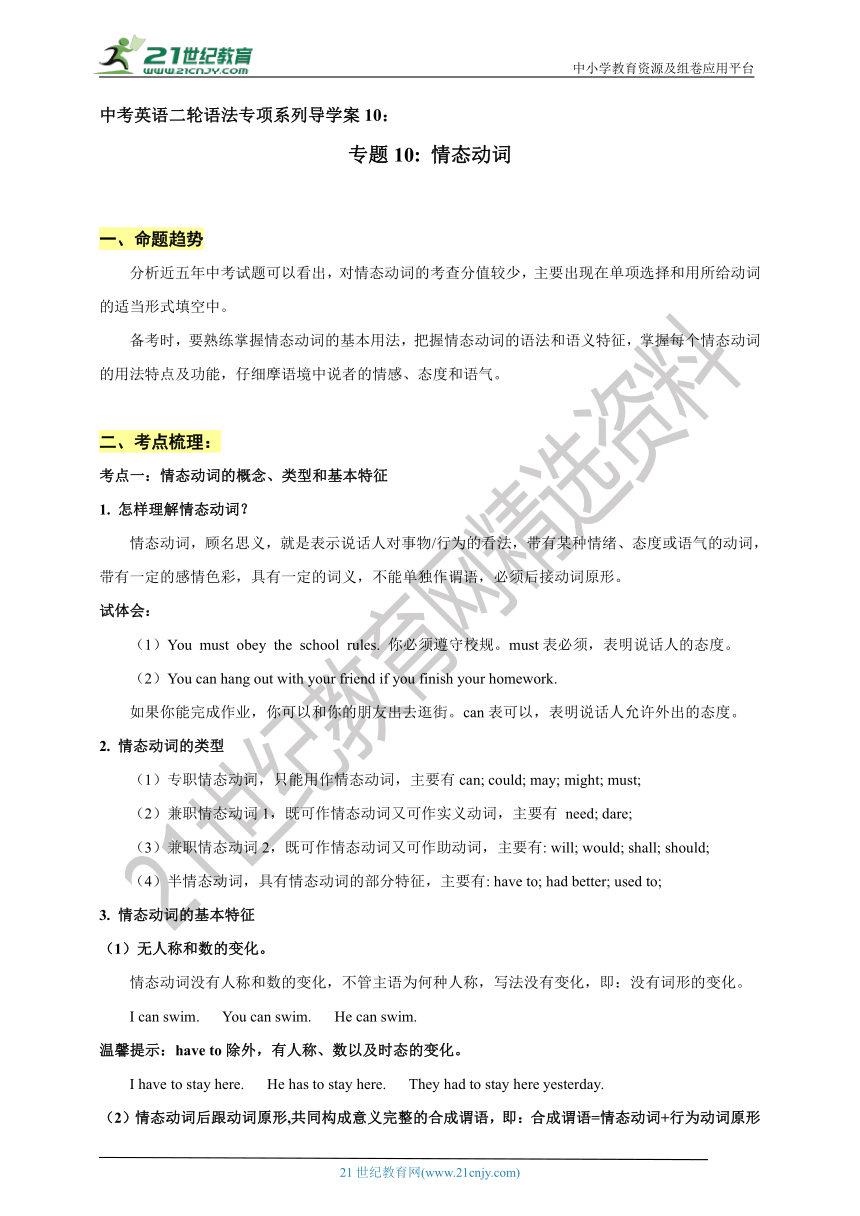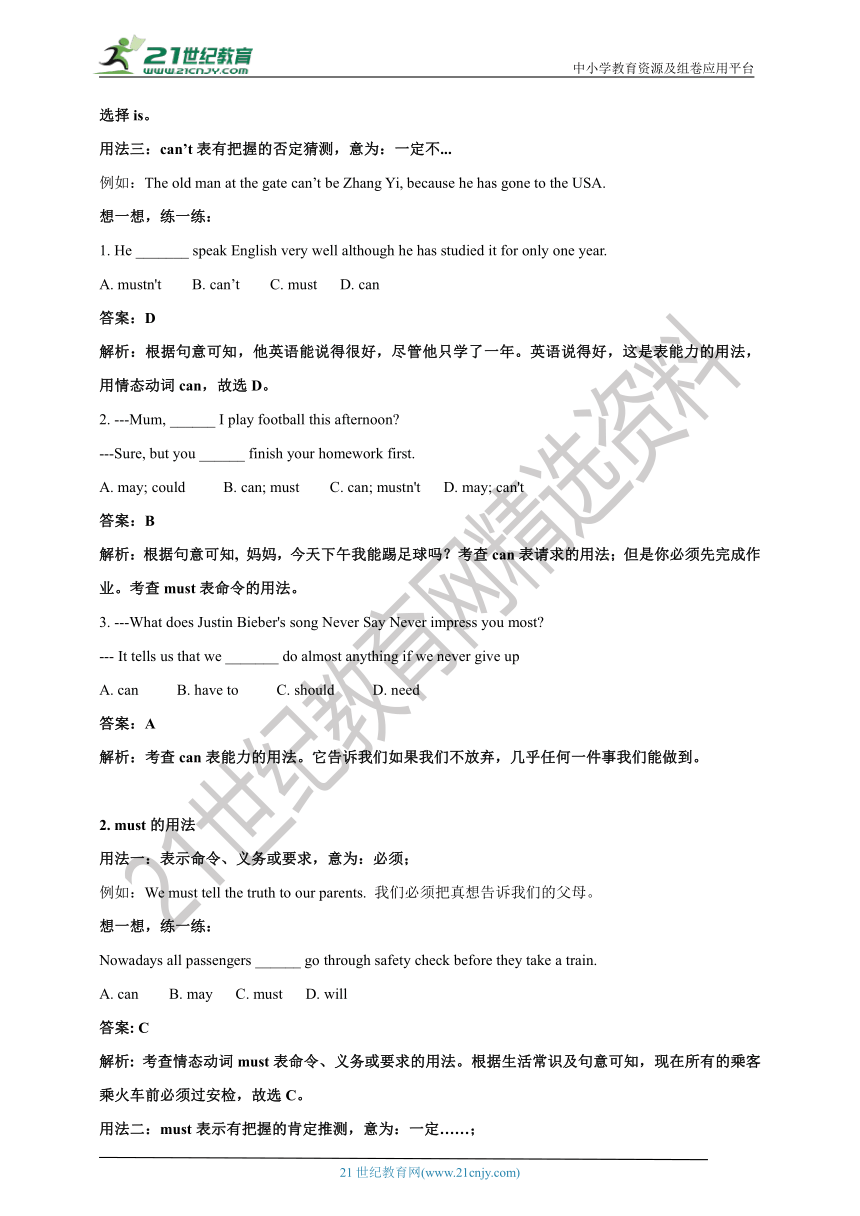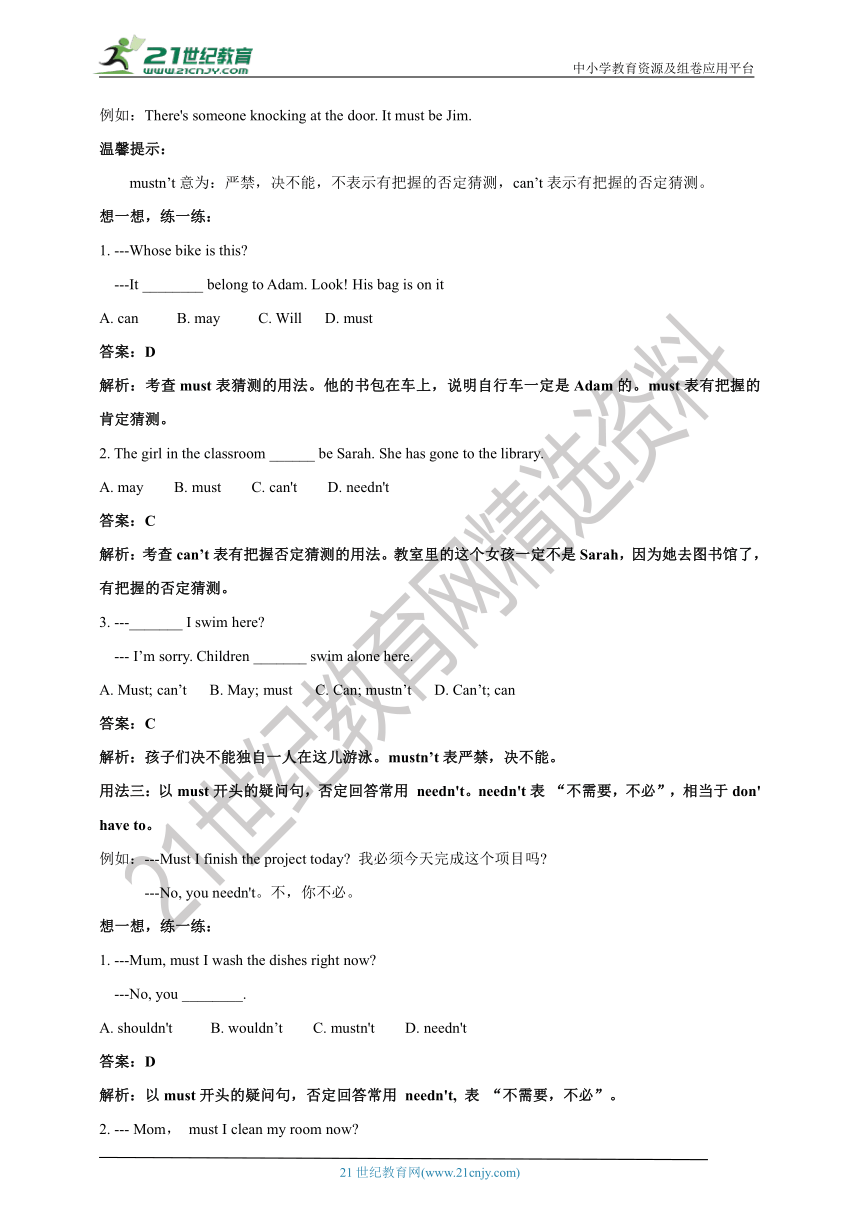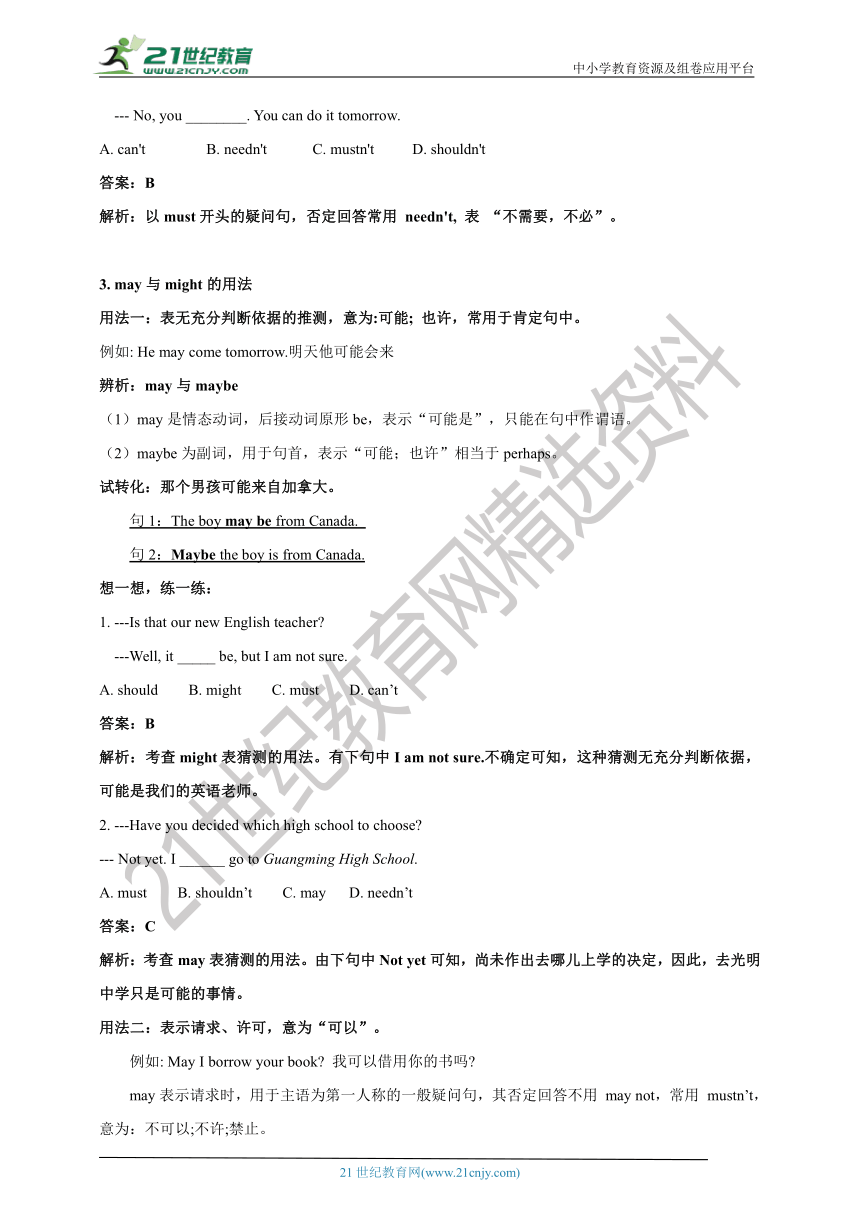中考英语二轮语法专项系列导学案10: 情态动词
文档属性
| 名称 | 中考英语二轮语法专项系列导学案10: 情态动词 |  | |
| 格式 | zip | ||
| 文件大小 | 972.6KB | ||
| 资源类型 | 试卷 | ||
| 版本资源 | 人教新目标(Go for it)版 | ||
| 科目 | 英语 | ||
| 更新时间 | 2019-08-10 19:42:16 | ||
图片预览





文档简介
中小学教育资源及组卷应用平台
中考英语二轮语法专项系列导学案10:
专题10: 情态动词
一、命题趋势
分析近五年中考试题可以看出,对情态动词的考查分值较少,主要出现在单项选择和用所给动词的适当形式填空中。
备考时,要熟练掌握情态动词的基本用法,把握情态动词的语法和语义特征,掌握每个情态动词的用法特点及功能,仔细摩语境中说者的情感、态度和语气。
二、考点梳理:
考点一:情态动词的概念、类型和基本特征
1. 怎样理解情态动词?
情态动词,顾名思义,就是表示说话人对事物/行为的看法,带有某种情绪、态度或语气的动词,带有一定的感彩,具有一定的词义,不能单独作谓语,必须后接动词原形。
试体会:
(1)You?must?obey?the?school?rules. 你必须遵守校规。must表必须,表明说话人的态度。
(2)You can hang out with your friend if you finish your homework.
如果你能完成作业,你可以和你的朋友出去逛街。can表可以,表明说话人允许外出的态度。
2. 情态动词的类型
(1)专职情态动词,只能用作情态动词,主要有can; could; may; might; must;
(2)兼职情态动词1,既可作情态动词又可作实义动词,主要有 need; dare;
(3)兼职情态动词2,既可作情态动词又可作助动词,主要有: will; would; shall; should;
(4)半情态动词,具有情态动词的部分特征,主要有: have to; had better; used to;
3. 情态动词的基本特征
(1)无人称和数的变化。
情态动词没有人称和数的变化,不管主语为何种人称,写法没有变化,即:没有词形的变化。
I can swim. You can swim. He can swim.
温馨提示:have to除外,有人称、数以及时态的变化。
I have to stay here. He has to stay here. They had to stay here yesterday.
(2)情态动词后跟动词原形,共同构成意义完整的合成谓语,即:合成谓语=情态动词+行为动词原形或系动词原形,此用法区别于实义动词。
例如:He can swim. He swims.
试划分句子成分:I can swim.
错误:I(主语) can(谓语)swim.(宾语) 正确:I(主语) can swim.(合成谓语)
温馨提示:正确划分句子成分,弄清情态动词的谓语角色,有助于宾语从句陈述与疑问语序的判断。
想一想,辨一辨:
① I don’t know if can he do the job. (错误) ② I don’t know if he can do the job. (正确)
If引导的宾语从句中,he为主语,can后加动词原形do构成合成谓语。①句中,谓语的一部分can放在主语he前面,为疑问语序,而宾语从句要求陈述语序(主语+全部谓语),所以,①句错误。
(3) 具有助动词的作用,可用来构成否定句、疑问句及用于简明答语。
例如: --- Can you sing an English song? 你会唱英语歌吗? --- Yes, I can. 是的,我会。
考点二:情态动词的用法
1. can, could的用法
用法一:表才能,有才。
can表示现在的能力,例如: We can speak a little English.我们会讲一点英语;could表示过去的能力,例如:Jimmy could read at the age of five.
be able to即可表现在/过去能力,又可指将来具备的能力。
例如: He was able to swim at the age of five. We are able to speak English well. Kate will be able to drive when she is 18 years old.
用法二:表示请求或许可
例如:You can play basketball on Saturday. 周六你们可以打篮球。表示许可。
Can you help me with my English? 你能帮我学英语吗?表示请求。
表请求时,could不是can的过去式,但比can更可气、更委婉。
想一想,练一练:
Could you please tell me ____________?
A. where was the restroom? B. where the restroom was?
C. where is the restroom? D. where the restroom is?
答案:D
解析:tell后常跟宾语从句,要求陈述语序,即:主语+全部谓语。选项A、C中谓语动词is、was放在主语的前面,疑问语序,排除;could表请求时,不是can的过去式,只是更委婉的请求,所以选择is。
用法三:can’t表有把握的否定猜测,意为:一定不...
例如:The old man at the gate can’t be Zhang Yi, because he has gone to the USA.
想一想,练一练:
1. He _______ speak English very well although he has studied it for only one year.
A. mustn't B. can’t C. must D. can
答案:D
解析:根据句意可知,他英语能说得很好,尽管他只学了一年。英语说得好,这是表能力的用法,用情态动词can,故选D。
2. ---Mum, ______ I play football this afternoon?
---Sure, but you ______ finish your homework first.
A. may; could B. can; must C. can; mustn't D. may; can't
答案:B
解析:根据句意可知, 妈妈,今天下午我能踢足球吗?考查can表请求的用法;但是你必须先完成作业。考查must表命令的用法。
3. ---What does Justin Bieber's song Never Say Never impress you most?
--- It tells us that we _______ do almost anything if we never give up
A. can B. have to C. should D. need
答案:A
解析:考查can表能力的用法。它告诉我们如果我们不放弃,几乎任何一件事我们能做到。
2. must的用法
用法一:表示命令、义务或要求,意为:必须;
例如:We must tell the truth to our parents. 我们必须把真想告诉我们的父母。
想一想,练一练:
Nowadays all passengers ______ go through safety check before they take a train.
A. can B. may C. must D. will
答案: C
解析: 考查情态动词must表命令、义务或要求的用法。根据生活常识及句意可知,现在所有的乘客乘火车前必须过安检,故选C。
用法二:must表示有把握的肯定推测,意为:一定……;
例如:There's someone knocking at the door. It must be Jim.
温馨提示:
mustn’t意为:严禁,决不能,不表示有把握的否定猜测,can’t表示有把握的否定猜测。
想一想,练一练:
1. ---Whose bike is this?
---It ________ belong to Adam. Look! His bag is on it
A. can B. may C. Will D. must
答案:D
解析:考查must表猜测的用法。他的书包在车上,说明自行车一定是Adam的。must表有把握的肯定猜测。
2. The girl in the classroom ______ be Sarah. She has gone to the library.
A. may B. must C. can't D. needn't
答案:C
解析:考查can’t表有把握否定猜测的用法。教室里的这个女孩一定不是Sarah,因为她去图书馆了,有把握的否定猜测。
3. ---_______ I swim here?
--- I’m sorry. Children _______ swim alone here.
A. Must; can’t B. May; must C. Can; mustn’t D. Can’t; can
答案:C
解析:孩子们决不能独自一人在这儿游泳。mustn’t表严禁,决不能。
用法三:以must开头的疑问句,否定回答常用 needn't。needn't表 “不需要,不必”,相当于don' have to。
例如:---Must I finish the project today? 我必须今天完成这个项目吗?
---No, you needn't。不,你不必。
想一想,练一练:
1. ---Mum, must I wash the dishes right now?
---No, you ________.
A. shouldn't B. wouldn’t C. mustn't D. needn't
答案:D
解析:以must开头的疑问句,否定回答常用 needn't, 表 “不需要,不必”。
2. --- Mom, must I clean my room now?
--- No, you ________. You can do it tomorrow.
A. can't B. needn't C. mustn't D. shouldn't
答案:B
解析:以must开头的疑问句,否定回答常用 needn't, 表 “不需要,不必”。
3. may与might的用法
用法一:表无充分判断依据的推测,意为:可能; 也许,常用于肯定句中。
例如: He may come tomorrow.明天他可能会来
辨析:may与maybe
(1)may是情态动词,后接动词原形be,表示“可能是”,只能在句中作谓语。
(2)maybe为副词,用于句首,表示“可能;也许”相当于perhaps。
试转化:那个男孩可能来自加拿大。
句1:The boy may be from Canada.
句2:Maybe the boy is from Canada.
想一想,练一练:
1. ---Is that our new English teacher?
---Well, it _____ be, but I am not sure.
A. should B. might C. must D. can’t
答案:B
解析:考查might表猜测的用法。有下句中I am not sure.不确定可知,这种猜测无充分判断依据,可能是我们的英语老师。
2. ---Have you decided which high school to choose?
--- Not yet. I ______ go to Guangming High School.
A. must B. shouldn’t C. may D. needn’t
答案:C
解析:考查may表猜测的用法。由下句中Not yet可知,尚未作出去哪儿上学的决定,因此,去光明中学只是可能的事情。
用法二:表示请求、许可,意为“可以”。
例如: May I borrow your book? 我可以借用你的书吗?
may表示请求时,用于主语为第一人称的一般疑问句,其否定回答不用 may not,常用 mustn’t,意为:不可以;不许;禁止。
例如: ---May I go now? 我现在可以走了吗? ---No, you mustn’t. 不,不可以。
can和may均可用来征求意见或允许,意为“可以”,一般可互换使用。
用法三:表示祝愿。例如:May you success! 祝你成功!
4. need与dare的用法
need与dare既可作情态动词,又可作实意动词,在用法上有相似之处,以need为例,见下表:
作实意动词 Sb need sth. 意为:某人需要某物; I need some fruit to eat.
Sb need to do sth.意为:某人需要做某事 I need to buy a new pen for my sister.
作情态动词 用于否定或疑问句中,后接动词原形,无人称数及时态的变化;
区分need或dare为情态动词还是实意动词的方法如下:
(1)有无人称和数的变化;
need或dare作情态动词时,无人称和数的变化;need或dare作实意动词时,无人称和数的变化;
(2)后接动词形式不同;
need或dare作情态动词时,后接动词原形;need或dare作实意动词时,后接动词不定式,即:need或dare to do sth。
He needn't get up early. = He doesn’t need to get up early. 他不需要早起。
He needn't worry about it. = He doesn't need to worry about it.。这件事他无需担心
(3)句式变换的方法不同;
need或dare作情态动词时,变否定句在后面加not,变一般疑问句时提前;need或dare作实意动词时,进行各种句式变换需借助助动词do, does, did实现。
想一想,练一练:
1. Lisa is a little poor at Chinese. I think she needs _______ it every day.
A. practice to speak B. to practice speaking C. practice speaking D. to practice to speak
答案:B
解析:needs有词形的变化,为实意动词,后跟动词不定式to practice;practice后面只能跟doing形式,所以选择B。
2. ---Must I clean the classroom right now?
--- _________.You can do it after class
A. Yes, you must. B. No, you can. C. Yes, you may D. No, you needn't
答案:D
解析:以must开头的疑问句,否定回答常用 needn't, 表 “不需要,不必”,相当于don' have to。
考点5:had better的用法
had better +动词原形,常用于提建议,没有人称和数的变化,意为:最好做某事,其否定句式为:had better not do sth。
例如:You'd better(not)stay at home。你最好(不要)待在家里。
想一想,练一练:You’d better _____ (not watch) TV every day.
答案:not watch
解析:had better not do sth。
考点6:shall( should), will( would)的用法
(1) shall用于第一人称,表示征求意见、询问。
例如:Shall I open the window? 我打开窗户好吗? Shall we have lunch here? 我们在这儿吃午饭好吗?
(2) should常用来表示义务或责任。
例如:We should obey traffic laws. 我们应该遵守交通规则。
(3) will用于第二人称,表示询问、请求,也可以表达现在的意愿。
例如:Will you pass me the book? 把书递给我好吗? We will do anything for you 我们会为你做任何事。
(4) would用来表示过去的意愿或委婉询问。
例如:Would you tell me the way to the station? 你能告诉我去车站的路吗
三、真题感悟练:
1. ---Must we finish our homework now
--- No, you ________.
A. needn't B. mustn't C. can’t D. may
2. --- Must he sing the song in English?
---No. he _______.
A. needn't B. can't C. mustn't
3. --- Have you decided which senior high school to choose?
--- Not yet. I _____ go to Moonlight Senior High School.
A. must B. shouldn’t C. may D. needn’t
4. You _____ jump onto a bus while it is still moving. It is too dangerous
A. can B. must C. can't D. mustn't????
5. There’s enough time for you to go to the airport. You _____ hurry now.
A. should B. needn't. C must D. can't
6. With the help of the new technology, you _____ e-mail your friends by mobile phone
A. can B. must C. need D. should
7. --- Could you help me with my English now?
---Yes. I _____
A. could B. can C. must D. couldn't
8. ---Will you go to the museum with me this afternoon?
--- Sorry, ______. My aunt is coming to see me.
A. I don't B. I can't C. I needn't D. I mustn’t
9. --- How is your friend coming?
---I’m not sure. He ______ drive here.
A. may B. can C. must D. will
10. ---- May I take my pet dog with me into the cinema?
--- The rule says no. So you ______.
A. can B. mustn't C. may D. needn’t
11. ---Who can it be?
---I’m not sure. It ______ be Lucy's friend, Lin Mei.
A. mustn't B. can't C. may D. must
12. According to a research, butterflies ______ see more colors than humans.
A. must B. need C. will D. can
13. --- Can I go fishing with you, Dad?
--- No, you ______. You ______ do your homework first
A. won’t; may B. can’t; must C. shouldn't; ought D. needn’t; should
14. --- ______ I take the magazine away from the reading room?
--- No, you mustn't. You _____ read it only here.
A. Must; must B. Must; can C. Need; must D. May; can
15. ---Sir, you ____ park your car in the middle of the road.
--- I ____ stop. A dog was running across the street.
A. mustn’t; needn’t B. needn’t; mustn’t C. mustn’t; must D. needn’t; need
真题提升练答案:
1. A 2. A 3. C 4. D 5. B
6. A 7. B 8. B 9. A 10. B
11. C 12. D 13. B 14. D 15. C
21世纪教育网 www.21cnjy.com 精品试卷·第 2 页 (共 2 页)
21世纪教育网(www.21cnjy.com)
中考英语二轮语法专项系列导学案10:
专题10: 情态动词
一、命题趋势
分析近五年中考试题可以看出,对情态动词的考查分值较少,主要出现在单项选择和用所给动词的适当形式填空中。
备考时,要熟练掌握情态动词的基本用法,把握情态动词的语法和语义特征,掌握每个情态动词的用法特点及功能,仔细摩语境中说者的情感、态度和语气。
二、考点梳理:
考点一:情态动词的概念、类型和基本特征
1. 怎样理解情态动词?
情态动词,顾名思义,就是表示说话人对事物/行为的看法,带有某种情绪、态度或语气的动词,带有一定的感彩,具有一定的词义,不能单独作谓语,必须后接动词原形。
试体会:
(1)You?must?obey?the?school?rules. 你必须遵守校规。must表必须,表明说话人的态度。
(2)You can hang out with your friend if you finish your homework.
如果你能完成作业,你可以和你的朋友出去逛街。can表可以,表明说话人允许外出的态度。
2. 情态动词的类型
(1)专职情态动词,只能用作情态动词,主要有can; could; may; might; must;
(2)兼职情态动词1,既可作情态动词又可作实义动词,主要有 need; dare;
(3)兼职情态动词2,既可作情态动词又可作助动词,主要有: will; would; shall; should;
(4)半情态动词,具有情态动词的部分特征,主要有: have to; had better; used to;
3. 情态动词的基本特征
(1)无人称和数的变化。
情态动词没有人称和数的变化,不管主语为何种人称,写法没有变化,即:没有词形的变化。
I can swim. You can swim. He can swim.
温馨提示:have to除外,有人称、数以及时态的变化。
I have to stay here. He has to stay here. They had to stay here yesterday.
(2)情态动词后跟动词原形,共同构成意义完整的合成谓语,即:合成谓语=情态动词+行为动词原形或系动词原形,此用法区别于实义动词。
例如:He can swim. He swims.
试划分句子成分:I can swim.
错误:I(主语) can(谓语)swim.(宾语) 正确:I(主语) can swim.(合成谓语)
温馨提示:正确划分句子成分,弄清情态动词的谓语角色,有助于宾语从句陈述与疑问语序的判断。
想一想,辨一辨:
① I don’t know if can he do the job. (错误) ② I don’t know if he can do the job. (正确)
If引导的宾语从句中,he为主语,can后加动词原形do构成合成谓语。①句中,谓语的一部分can放在主语he前面,为疑问语序,而宾语从句要求陈述语序(主语+全部谓语),所以,①句错误。
(3) 具有助动词的作用,可用来构成否定句、疑问句及用于简明答语。
例如: --- Can you sing an English song? 你会唱英语歌吗? --- Yes, I can. 是的,我会。
考点二:情态动词的用法
1. can, could的用法
用法一:表才能,有才。
can表示现在的能力,例如: We can speak a little English.我们会讲一点英语;could表示过去的能力,例如:Jimmy could read at the age of five.
be able to即可表现在/过去能力,又可指将来具备的能力。
例如: He was able to swim at the age of five. We are able to speak English well. Kate will be able to drive when she is 18 years old.
用法二:表示请求或许可
例如:You can play basketball on Saturday. 周六你们可以打篮球。表示许可。
Can you help me with my English? 你能帮我学英语吗?表示请求。
表请求时,could不是can的过去式,但比can更可气、更委婉。
想一想,练一练:
Could you please tell me ____________?
A. where was the restroom? B. where the restroom was?
C. where is the restroom? D. where the restroom is?
答案:D
解析:tell后常跟宾语从句,要求陈述语序,即:主语+全部谓语。选项A、C中谓语动词is、was放在主语的前面,疑问语序,排除;could表请求时,不是can的过去式,只是更委婉的请求,所以选择is。
用法三:can’t表有把握的否定猜测,意为:一定不...
例如:The old man at the gate can’t be Zhang Yi, because he has gone to the USA.
想一想,练一练:
1. He _______ speak English very well although he has studied it for only one year.
A. mustn't B. can’t C. must D. can
答案:D
解析:根据句意可知,他英语能说得很好,尽管他只学了一年。英语说得好,这是表能力的用法,用情态动词can,故选D。
2. ---Mum, ______ I play football this afternoon?
---Sure, but you ______ finish your homework first.
A. may; could B. can; must C. can; mustn't D. may; can't
答案:B
解析:根据句意可知, 妈妈,今天下午我能踢足球吗?考查can表请求的用法;但是你必须先完成作业。考查must表命令的用法。
3. ---What does Justin Bieber's song Never Say Never impress you most?
--- It tells us that we _______ do almost anything if we never give up
A. can B. have to C. should D. need
答案:A
解析:考查can表能力的用法。它告诉我们如果我们不放弃,几乎任何一件事我们能做到。
2. must的用法
用法一:表示命令、义务或要求,意为:必须;
例如:We must tell the truth to our parents. 我们必须把真想告诉我们的父母。
想一想,练一练:
Nowadays all passengers ______ go through safety check before they take a train.
A. can B. may C. must D. will
答案: C
解析: 考查情态动词must表命令、义务或要求的用法。根据生活常识及句意可知,现在所有的乘客乘火车前必须过安检,故选C。
用法二:must表示有把握的肯定推测,意为:一定……;
例如:There's someone knocking at the door. It must be Jim.
温馨提示:
mustn’t意为:严禁,决不能,不表示有把握的否定猜测,can’t表示有把握的否定猜测。
想一想,练一练:
1. ---Whose bike is this?
---It ________ belong to Adam. Look! His bag is on it
A. can B. may C. Will D. must
答案:D
解析:考查must表猜测的用法。他的书包在车上,说明自行车一定是Adam的。must表有把握的肯定猜测。
2. The girl in the classroom ______ be Sarah. She has gone to the library.
A. may B. must C. can't D. needn't
答案:C
解析:考查can’t表有把握否定猜测的用法。教室里的这个女孩一定不是Sarah,因为她去图书馆了,有把握的否定猜测。
3. ---_______ I swim here?
--- I’m sorry. Children _______ swim alone here.
A. Must; can’t B. May; must C. Can; mustn’t D. Can’t; can
答案:C
解析:孩子们决不能独自一人在这儿游泳。mustn’t表严禁,决不能。
用法三:以must开头的疑问句,否定回答常用 needn't。needn't表 “不需要,不必”,相当于don' have to。
例如:---Must I finish the project today? 我必须今天完成这个项目吗?
---No, you needn't。不,你不必。
想一想,练一练:
1. ---Mum, must I wash the dishes right now?
---No, you ________.
A. shouldn't B. wouldn’t C. mustn't D. needn't
答案:D
解析:以must开头的疑问句,否定回答常用 needn't, 表 “不需要,不必”。
2. --- Mom, must I clean my room now?
--- No, you ________. You can do it tomorrow.
A. can't B. needn't C. mustn't D. shouldn't
答案:B
解析:以must开头的疑问句,否定回答常用 needn't, 表 “不需要,不必”。
3. may与might的用法
用法一:表无充分判断依据的推测,意为:可能; 也许,常用于肯定句中。
例如: He may come tomorrow.明天他可能会来
辨析:may与maybe
(1)may是情态动词,后接动词原形be,表示“可能是”,只能在句中作谓语。
(2)maybe为副词,用于句首,表示“可能;也许”相当于perhaps。
试转化:那个男孩可能来自加拿大。
句1:The boy may be from Canada.
句2:Maybe the boy is from Canada.
想一想,练一练:
1. ---Is that our new English teacher?
---Well, it _____ be, but I am not sure.
A. should B. might C. must D. can’t
答案:B
解析:考查might表猜测的用法。有下句中I am not sure.不确定可知,这种猜测无充分判断依据,可能是我们的英语老师。
2. ---Have you decided which high school to choose?
--- Not yet. I ______ go to Guangming High School.
A. must B. shouldn’t C. may D. needn’t
答案:C
解析:考查may表猜测的用法。由下句中Not yet可知,尚未作出去哪儿上学的决定,因此,去光明中学只是可能的事情。
用法二:表示请求、许可,意为“可以”。
例如: May I borrow your book? 我可以借用你的书吗?
may表示请求时,用于主语为第一人称的一般疑问句,其否定回答不用 may not,常用 mustn’t,意为:不可以;不许;禁止。
例如: ---May I go now? 我现在可以走了吗? ---No, you mustn’t. 不,不可以。
can和may均可用来征求意见或允许,意为“可以”,一般可互换使用。
用法三:表示祝愿。例如:May you success! 祝你成功!
4. need与dare的用法
need与dare既可作情态动词,又可作实意动词,在用法上有相似之处,以need为例,见下表:
作实意动词 Sb need sth. 意为:某人需要某物; I need some fruit to eat.
Sb need to do sth.意为:某人需要做某事 I need to buy a new pen for my sister.
作情态动词 用于否定或疑问句中,后接动词原形,无人称数及时态的变化;
区分need或dare为情态动词还是实意动词的方法如下:
(1)有无人称和数的变化;
need或dare作情态动词时,无人称和数的变化;need或dare作实意动词时,无人称和数的变化;
(2)后接动词形式不同;
need或dare作情态动词时,后接动词原形;need或dare作实意动词时,后接动词不定式,即:need或dare to do sth。
He needn't get up early. = He doesn’t need to get up early. 他不需要早起。
He needn't worry about it. = He doesn't need to worry about it.。这件事他无需担心
(3)句式变换的方法不同;
need或dare作情态动词时,变否定句在后面加not,变一般疑问句时提前;need或dare作实意动词时,进行各种句式变换需借助助动词do, does, did实现。
想一想,练一练:
1. Lisa is a little poor at Chinese. I think she needs _______ it every day.
A. practice to speak B. to practice speaking C. practice speaking D. to practice to speak
答案:B
解析:needs有词形的变化,为实意动词,后跟动词不定式to practice;practice后面只能跟doing形式,所以选择B。
2. ---Must I clean the classroom right now?
--- _________.You can do it after class
A. Yes, you must. B. No, you can. C. Yes, you may D. No, you needn't
答案:D
解析:以must开头的疑问句,否定回答常用 needn't, 表 “不需要,不必”,相当于don' have to。
考点5:had better的用法
had better +动词原形,常用于提建议,没有人称和数的变化,意为:最好做某事,其否定句式为:had better not do sth。
例如:You'd better(not)stay at home。你最好(不要)待在家里。
想一想,练一练:You’d better _____ (not watch) TV every day.
答案:not watch
解析:had better not do sth。
考点6:shall( should), will( would)的用法
(1) shall用于第一人称,表示征求意见、询问。
例如:Shall I open the window? 我打开窗户好吗? Shall we have lunch here? 我们在这儿吃午饭好吗?
(2) should常用来表示义务或责任。
例如:We should obey traffic laws. 我们应该遵守交通规则。
(3) will用于第二人称,表示询问、请求,也可以表达现在的意愿。
例如:Will you pass me the book? 把书递给我好吗? We will do anything for you 我们会为你做任何事。
(4) would用来表示过去的意愿或委婉询问。
例如:Would you tell me the way to the station? 你能告诉我去车站的路吗
三、真题感悟练:
1. ---Must we finish our homework now
--- No, you ________.
A. needn't B. mustn't C. can’t D. may
2. --- Must he sing the song in English?
---No. he _______.
A. needn't B. can't C. mustn't
3. --- Have you decided which senior high school to choose?
--- Not yet. I _____ go to Moonlight Senior High School.
A. must B. shouldn’t C. may D. needn’t
4. You _____ jump onto a bus while it is still moving. It is too dangerous
A. can B. must C. can't D. mustn't????
5. There’s enough time for you to go to the airport. You _____ hurry now.
A. should B. needn't. C must D. can't
6. With the help of the new technology, you _____ e-mail your friends by mobile phone
A. can B. must C. need D. should
7. --- Could you help me with my English now?
---Yes. I _____
A. could B. can C. must D. couldn't
8. ---Will you go to the museum with me this afternoon?
--- Sorry, ______. My aunt is coming to see me.
A. I don't B. I can't C. I needn't D. I mustn’t
9. --- How is your friend coming?
---I’m not sure. He ______ drive here.
A. may B. can C. must D. will
10. ---- May I take my pet dog with me into the cinema?
--- The rule says no. So you ______.
A. can B. mustn't C. may D. needn’t
11. ---Who can it be?
---I’m not sure. It ______ be Lucy's friend, Lin Mei.
A. mustn't B. can't C. may D. must
12. According to a research, butterflies ______ see more colors than humans.
A. must B. need C. will D. can
13. --- Can I go fishing with you, Dad?
--- No, you ______. You ______ do your homework first
A. won’t; may B. can’t; must C. shouldn't; ought D. needn’t; should
14. --- ______ I take the magazine away from the reading room?
--- No, you mustn't. You _____ read it only here.
A. Must; must B. Must; can C. Need; must D. May; can
15. ---Sir, you ____ park your car in the middle of the road.
--- I ____ stop. A dog was running across the street.
A. mustn’t; needn’t B. needn’t; mustn’t C. mustn’t; must D. needn’t; need
真题提升练答案:
1. A 2. A 3. C 4. D 5. B
6. A 7. B 8. B 9. A 10. B
11. C 12. D 13. B 14. D 15. C
21世纪教育网 www.21cnjy.com 精品试卷·第 2 页 (共 2 页)
21世纪教育网(www.21cnjy.com)
同课章节目录
- 词法
- 名词
- 动词和动词短语
- 动词语态
- 动词时态
- 助动词和情态动词
- 非谓语动词
- 冠词
- 代词
- 数词和量词
- 形容词副词及其比较等级
- 介词和介词短语
- 连词和感叹词
- 构词法
- 相似、相近词比较
- 句法
- 陈述句
- 一般疑问句和否定疑问句
- 特殊疑问句及选择疑问句
- 反意疑问句
- 存在句(There be句型)
- 宾语从句
- 定语从句
- 状语从句
- 主谓一致问题
- 简单句
- 并列句
- 复合句
- 主谓一致
- 主、表语从句
- 名词性从句
- 直接引语和间接引语
- 虚拟语气
- 感叹句
- 强调句
- 倒装句
- 祈使句
- 句子的成分
- 句子的分类
- 题型专区
- 单项选择部分
- 易错题
- 完形填空
- 阅读理解
- 词汇练习
- 听说训练
- 句型转换
- 补全对话
- 短文改错
- 翻译
- 书面表达
- 任务型阅读
- 语法填空
- 其他资料
